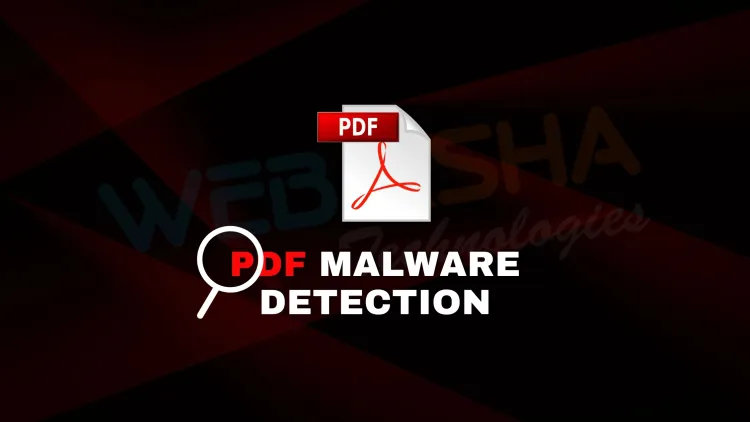How can beginners detect and analyze PDF malware step by step?
Learn how to detect and analyze PDF malware using simple, beginner-friendly steps. PDF malware is a growing cyber threat where attackers embed malicious JavaScript, links, or files inside PDF documents. This guide explains how to set up a safe malware analysis environment, identify suspicious PDF characteristics, extract and analyze hidden JavaScript, review embedded files and links, perform static and dynamic analysis, and use free tools like pdfid.py, pdf-parser.py, VirusTotal, and CyberChef. The blog is designed for IT professionals, students, and cybersecurity beginners looking to develop hands-on malware analysis skills without needing advanced experience.

Table of Contents
- Why Is PDF Malware Dangerous
- How Does PDF Malware Work?
- Step-by-Step Guide to Detect and Analyze PDF Malware
- Tools List for PDF Malware Analysis
- Beginner-Friendly Tips
- Example Scenario Walkthrough
- Conclusion
- Frequently Asked Questions (FAQs)
In today’s digital landscape, PDF files are not just for sharing documents—they’re also a growing tool for cyber attackers. Many phishing campaigns and malware attacks now embed malicious code inside PDF files, exploiting software vulnerabilities or tricking users into clicking dangerous links.
If you’re a cybersecurity beginner or an IT professional interested in malware analysis, this guide will walk you through how to detect and analyze PDF malware step by step using beginner-friendly methods.
Why Is PDF Malware Dangerous?
PDF malware is particularly dangerous because:
-
Most people trust PDF files and open them without thinking.
-
Antivirus software may not always detect hidden scripts or exploits.
-
PDFs can carry JavaScript, embedded files, or malicious links.
-
Attackers use social engineering techniques like fake invoices or resumes.
Real Example:
In June 2025, researchers reported a phishing campaign where fake tax refund notices attached as PDF files triggered malware downloads, bypassing email filters in major financial firms.
How Does PDF Malware Work?
PDF malware can hide in:
-
Embedded JavaScript (launch actions, auto-execution scripts).
-
Hidden links leading to malicious websites.
-
Embedded files like EXE or ZIP archives.
-
Exploits targeting PDF reader vulnerabilities (e.g., buffer overflow).
Step-by-Step Guide to Detect and Analyze PDF Malware
Here’s how beginners can analyze potentially malicious PDFs safely:
Step 1: Set Up a Safe Malware Analysis Environment
Before opening any suspicious PDF, create a controlled environment:
-
Use a virtual machine (VM) with no internet access.
-
Install PDF analysis tools (details below).
-
Disable PDF reader auto-execution of JavaScript or external links.
Tools to Set Up:
-
VirtualBox or VMware
-
Windows Sandbox or Kali Linux
-
PDF Reader with security settings configured
Step 2: Identify Suspicious PDF Characteristics
Ask these basic questions:
-
Was the PDF from an unknown source?
-
Is the file unusually large or encrypted?
-
Does it prompt to enable JavaScript or external content?
Use tools like:
-
VirusTotal (https://www.virustotal.com)
-
Hybrid Analysis (https://www.hybrid-analysis.com)
Upload the PDF to scan for known malware signatures.
Step 3: Analyze PDF Metadata
Extract metadata to check for hidden information such as author, creation tool, and suspicious content.
Tools:
-
pdfid.py by Didier Stevens
Command:python pdfid.py suspicious.pdf
Look for:
-
/JavaScript
-
/OpenAction
-
/AA (Additional Actions)
Example Output:
/JavaScript: 1
/OpenAction: 1
These flags suggest potential malware behavior.
Step 4: Extract and Review Embedded JavaScript
If JavaScript is present:
-
Use pdf-parser.py to extract JavaScript code.
Command:python pdf-parser.py suspicious.pdf -s /JavaScript -
Decode obfuscated scripts manually or using online JS beautifiers like https://beautifier.io.
Watch for:
-
Obfuscated code (XOR, Base64).
-
Links to external malicious domains.
-
Exploit code targeting PDF reader vulnerabilities.
Step 5: Analyze Embedded Files and Links
Many malicious PDFs contain embedded executables or links.
Commands:
-
python pdf-parser.py suspicious.pdf -o(to check embedded files) -
Use a hex editor or CyberChef to review embedded file signatures.
Look for:
-
.exe, .bat, .cmd files hidden in attachments.
-
Links to suspicious URLs.
Step 6: Dynamic Analysis (If Safe)
If static analysis isn’t conclusive, open the PDF in your virtual machine while monitoring:
-
System calls using Process Monitor.
-
Network traffic using Wireshark.
-
Suspicious behavior using a sandbox like Any.Run.
Warning:
Only do this if you understand the risks and your system is properly isolated!
Step 7: Correlate with Threat Intelligence
Check indicators you find (URLs, file hashes, JavaScript snippets) against:
-
VirusTotal
-
AbuseIPDB
-
ThreatFox by Abuse.ch
You may discover known malware campaigns linked to your PDF sample.
Tools List for PDF Malware Analysis
| Tool Name | Purpose | Link |
|---|---|---|
| pdfid.py | Metadata and suspicious tag detection | https://github.com/DidierStevens/pdfid |
| pdf-parser.py | Full PDF structure analysis and script extraction | https://github.com/DidierStevens/pdf-parser |
| VirusTotal | Multi-engine malware scanning | https://www.virustotal.com |
| CyberChef | Manual decoding and analysis | https://gchq.github.io/CyberChef/ |
| Any.Run | Online dynamic malware sandbox | https://any.run |
Beginner-Friendly Tips
-
Always analyze PDFs in a sandbox or VM.
-
Disable JavaScript in your PDF reader settings.
-
Don’t trust PDFs from unknown or suspicious email attachments.
-
Practice with publicly available malware samples (check MalwareBazaar or VirusShare).
Example Scenario Walkthrough
Imagine receiving a PDF invoice named "Payment-Details-2025.pdf."
-
Upload it to VirusTotal—several engines flag it as malicious.
-
Run pdfid.py—finds /JavaScript and /OpenAction.
-
Use pdf-parser.py—extracts obfuscated Base64-encoded JavaScript.
-
Decode the script—reveals a URL leading to a malicious ZIP file download.
-
Check URL on ThreatFox—confirms it's part of a known malware campaign.
Conclusion
PDF malware is increasingly used in real-world cyberattacks because it blends social engineering with technical exploits. By following this beginner-friendly step-by-step guide, you can start detecting and analyzing PDF-based malware safely and methodically.
FAQs
What is PDF malware?
PDF malware is a type of malicious code hidden inside PDF files. It can exploit software vulnerabilities, run hidden scripts, or trick users into downloading harmful content.
How do hackers use PDF files for cyberattacks?
Hackers embed malicious JavaScript, hidden links, or exploit code in PDF files. When victims open the file, malware executes or redirects them to phishing sites.
How can beginners detect PDF malware?
Beginners can use free tools like pdfid.py, pdf-parser.py, and VirusTotal to analyze PDFs for hidden scripts, embedded files, and suspicious links.
Is PDF malware detectable by antivirus software?
Sometimes yes, but many PDF malware variants use obfuscation techniques that traditional antivirus software may miss.
Why is JavaScript inside PDF files dangerous?
JavaScript can automate actions like opening websites or downloading files, allowing malware to spread without user interaction.
How do I analyze a PDF file for malware?
Set up a safe environment (like a virtual machine), scan the file with VirusTotal, check metadata using pdfid.py, extract scripts with pdf-parser.py, and observe behavior in a sandbox.
What is pdfid.py?
pdfid.py is a Python tool used to detect suspicious tags like /JavaScript or /OpenAction in PDF files, indicating potential malware.
What is pdf-parser.py?
pdf-parser.py allows deep inspection of PDF file structures, extracting hidden JavaScript or embedded files for analysis.
Can PDFs contain executable files?
Yes, attackers can embed EXE, ZIP, or other file types inside PDFs using embedded file objects.
How can I safely open a suspicious PDF file?
Only open it in a virtual machine or sandbox environment with internet access disabled and PDF reader security settings configured.
What tools do professionals use for PDF malware analysis?
Professionals use tools like pdfid.py, pdf-parser.py, CyberChef, VirusTotal, Any.Run, and Wireshark for dynamic behavior monitoring.
How do I check if a PDF has malicious links?
Extract the PDF content using pdf-parser.py or open it in a hex editor to search for URLs or JavaScript redirects.
What is static PDF malware analysis?
Static analysis involves examining the PDF file’s structure, metadata, and embedded content without executing it.
What is dynamic PDF malware analysis?
Dynamic analysis means running the PDF file in a controlled environment to observe its behavior, like system changes or network traffic.
Is PDF malware common in phishing emails?
Yes, PDF malware is widely used in phishing campaigns, especially for fake invoices, tax documents, and HR-related attachments.
How can businesses protect against PDF malware?
Businesses should implement email security solutions, disable JavaScript in PDF readers, educate employees, and use content inspection tools.
What does /OpenAction mean in a PDF?
/OpenAction is a PDF feature that executes an action (like JavaScript) automatically when the file is opened—often abused by malware.
How do I remove PDF malware?
You can delete the infected file, scan the system with updated antivirus, and restore affected systems from clean backups.
Can PDF malware affect mobile devices?
Yes, if PDF viewer apps don’t have proper security measures, mobile devices can also be exploited through malicious PDFs.
What is Base64 in PDF malware?
Attackers often encode JavaScript or embedded files in Base64 format within PDFs to evade detection.
How do I decode obfuscated JavaScript in PDFs?
Use pdf-parser.py to extract it, then decode using online tools like CyberChef or JavaScript beautifiers.
How can I check if a PDF is safe before opening?
Upload it to VirusTotal or use a PDF analysis tool to inspect its structure without opening it on your main device.
Are there online platforms to analyze PDF malware?
Yes, services like Any.Run, Hybrid Analysis, and VirusTotal allow online malware scanning and behavior analysis.
What is sandbox analysis for PDF files?
Sandbox analysis runs the PDF in a controlled virtual environment to monitor its behavior and detect hidden malware.
What’s the difference between embedded files and JavaScript in PDF malware?
Embedded files usually contain other file types like executables, while JavaScript executes malicious code directly within the PDF viewer.
How do attackers bypass antivirus detection with PDF malware?
They use obfuscation, encryption, and file format tricks like embedding malware inside scripts or less-monitored tags.
Can I analyze PDF malware on Windows?
Yes, but it’s safer to use a virtual machine or Windows Sandbox to avoid infecting your host system.
What is a PDF malware indicator of compromise (IOC)?
IOCs include suspicious file hashes, URLs, JavaScript patterns, embedded file signatures, and behavioral signs noted during analysis.
How long does it take to analyze a PDF for malware?
Basic analysis can take 15–30 minutes for beginners, while advanced inspection may take hours depending on file complexity.
Can PDF malware spread automatically?
Most PDF malware requires user interaction (like opening the file), but some advanced exploits can trigger automatically via vulnerabilities.














![Top 10 Ethical Hackers in the World [2025]](https://www.webasha.com/blog/uploads/images/202408/image_100x75_66c2f983c207b.webp)








